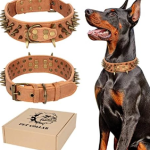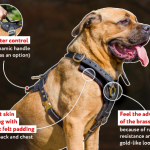Dog Carrier
Introduction
Dog carriers are indispensable tools for pet owners who travel frequently or need to transport their furry companions safely. Whether you’re planning a weekend getaway, a visit to the vet, or a cross-country move, the right dog carrier can make all the difference in ensuring your pet’s comfort and security. In this comprehensive guide, we’ll explore everything you need to know about dog carriers, from types and features to tips on choosing the best one for your dog’s needs.
What is a Dog Carrier?
A dog carrier is a portable enclosure designed to transport dogs safely and comfortably. Unlike traditional crates, which are typically used for home confinement or training, dog carriers are often used for travel, providing a secure and cozy environment for your pet during transit. They come in various styles, sizes, and materials, each catering to different needs and preferences.
Types of Dog Carriers
1. Soft-Sided Carriers
Soft-sided carriers are made from flexible materials such as nylon or mesh. They are popular for their lightweight and collapsible design, making them easy to store when not in use. These carriers often feature multiple mesh panels for ventilation and are usually approved for airline travel.
Advantages: Dog Carrier
- Comfortable and Flexible: Soft sides can adjust to fit under seats in airplanes.
- Breathable: Mesh panels provide excellent airflow.
- Easy to Clean: Removable and washable liners.
Disadvantages:Dog Carrier
- Less Durable: May not be suitable for heavy chewers or rough use.
- Limited Security: Some designs might not be as secure as hard-sided carriers.
2. Hard-Sided Carriers
Hard-sided carriers are constructed from rigid plastic or metal and offer superior durability. They are often used for longer trips or by owners who need a more secure option for their pets.
Advantages:
- Durable and Sturdy: Ideal for rough handling or more active pets.
- Secure: Provides a high level of protection.
- Easier to Clean: Hard surfaces are less likely to absorb odors or stains.
Disadvantages:
- Bulkier: Less flexible and harder to store.
- Heavier: Can be cumbersome to carry.
3. Rolling Carriers
Rolling carriers are designed with wheels and a retractable handle, allowing for easy maneuvering. They combine the convenience of a soft-sided carrier with the ease of rolling luggage.
Advantages:
- Easy to Transport: Ideal for longer distances or heavy pets.
- Versatile: Can be used as both a carrier and a rolling bag.
Disadvantages:
- Less Compact: Takes up more space when not in use.
- Wheels May Wear Out: Durability of wheels can vary.
4. Backpack Carriers
Backpack carriers allow you to carry your dog on your back. They are perfect for hikers or those who need to keep their hands free.
Advantages:
- Hands-Free Travel: Ideal for active lifestyles.
- Convenient for Small Dogs: Perfect for smaller breeds or puppies.
Disadvantages:
- Limited to Small Dogs: Not suitable for larger breeds.
- Comfort Issues: Can be uncomfortable for both the pet and the owner if not well-designed.
5. Pet Trolleys
Pet trolleys are a hybrid between a carrier and a stroller, offering comfort for both you and your pet. They are ideal for urban settings where pets need to be transported frequently.
Advantages:
- Comfortable Ride: Provides a smooth and comfortable journey.
- Convenient Storage: Often includes extra compartments for pet essentials.
Disadvantages:
- Bulky: Can be challenging to navigate in tight spaces.
- Expensive: Generally more costly than other types of carriers.
How to Choose the Right Dog Carrier
Choosing the right dog carrier involves considering several factors to ensure it meets your pet’s needs and your lifestyle. Here are some essential aspects to keep in mind:
1. Size and Fit Dog Carrier
The carrier should be the right size for your dog. It should be spacious enough for your pet to stand, turn around, and lie down comfortably but not so large that they can slide around. Measure your dog’s length and height and compare it with the carrier’s dimensions.
2. Comfort
Look for carriers with padded interiors, adequate ventilation, and enough room for your dog to move comfortably. For long trips, ensure the carrier has a comfortable and washable liner.
3. Durability
Consider the carrier’s material and construction. Soft-sided carriers are great for comfort but may not be as durable as hard-sided options. Choose a carrier that matches your pet’s behavior and travel needs.
4. Ease of Use
The carrier should be easy to open, close, and carry. Features like multiple entry points, removable liners, and adjustable straps can make the carrier more user-friendly.
5. Travel Requirements
If you plan to travel by air, make sure the carrier meets airline regulations. Airlines typically have specific requirements for pet carriers, including size restrictions and ventilation needs.
6. Safety Features
Check for safety features such as secure zippers, sturdy handles, and non-slip bases. Some carriers also come with additional safety measures like reflective strips or safety belts.
FAQ Section Dog Carrier
Q1: Can I use a dog carrier for air travel?
Yes, many dog carriers are designed specifically for air travel. It’s crucial to check with your airline for their specific requirements, including size restrictions and approved materials. Most airlines allow soft-sided carriers that fit under the seat in front of you.
Q2: How do I clean a dog carrier?
Cleaning methods vary depending on the carrier type. Soft-sided carriers often have removable, washable liners. For hard-sided carriers, wipe down the surfaces with a pet-safe cleaner. Always follow the manufacturer’s cleaning instructions to avoid damaging the carrier.
Q3: How do I get my dog accustomed to a carrier?
Introduce the carrier gradually by placing it in your home with the door open. Use treats and toys to make it a positive space. Start with short periods and gradually increase the time your dog spends in the carrier to help them get used to it.
Q4: Are there carriers specifically for small dogs?
Yes, many carriers are designed specifically for small dogs. Backpack carriers, soft-sided carriers, and rolling carriers often cater to smaller breeds. Always check the dimensions and weight limits to ensure the carrier is suitable for your dog.
Q5: What if my dog is anxious in the carrier?
If your dog is anxious, try to create a positive association with the carrier. Use treats, toys, and praise to reward your dog for spending time in the carrier. Consider gradual desensitization and consult a veterinarian or a pet behaviorist for additional strategies.
Conclusion
Choosing the right dog carrier is essential for the comfort and safety of your furry friend. With various types available—each offering different advantages and features—it’s important to consider your dog’s specific needs and travel habits. Whether you opt for a soft-sided carrier for air travel or a durable hard-sided carrier for long road trips, the right choice will ensure that your pet travels in comfort and style.
By taking into account factors such as size, comfort, durability, and safety, you can make an informed decision that benefits both you and your pet. Remember to follow airline regulations if traveling by air and always prioritize your pet’s comfort and security.
With this guide, you’re now equipped with the knowledge to choose the perfect dog carrier for your beloved companion. Safe travels and happy adventures with your furry friend!






